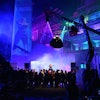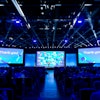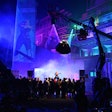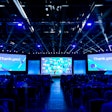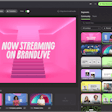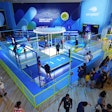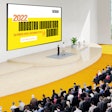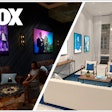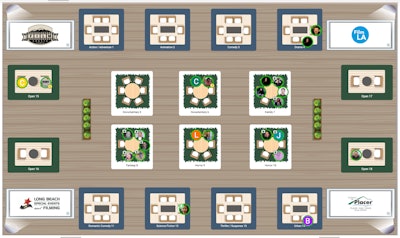
It’s one of the best things about an in-person trade show or conference: walking into a crowded theater or networking reception, grabbing an open seat, and starting a casual conversation with those around you. These serendipitous connections lead to lasting friendships and business relationships—and are undoubtedly one of the things most sorely missed with the absence of large, in-person events.
But American Film Market (AFM) may have found a way to recreate that feeling for the 41st edition of its annual trade show, which was held virtually from Nov. 9-13. The event—which is typically held in person in Santa Monica, Calif., and has long been a staple of BizBash’s Top 100 Events list—allows the global entertainment industry to gather and license the international rights for motion pictures. It traditionally results in a whopping $1 billion in deals every year—so canceling was not an option.
Planned in just four months, last week's virtual trade show ended up breaking records: Participants joined from 78 countries (more countries than any AFM in the last decade) and 42 U.S. states. There were also a record 562 exhibitors. The event was tied together by a 3D home screen. Attendees clicked on various buildings to build their profiles, book meetings with international buyers and production companies, view live panels and on-demand film screenings, and more.Screenshot: Courtesy of American Film Market
The event was tied together by a 3D home screen. Attendees clicked on various buildings to build their profiles, book meetings with international buyers and production companies, view live panels and on-demand film screenings, and more.Screenshot: Courtesy of American Film Market
Organizers accommodated this international group of attendees in a few different ways, like by making film screenings available 24/7 and making all content available on-demand for those in different time zones. But one of the most notable features was the trade show’s unique networking pavilion, which allowed for both preplanned meetings and spontaneous face-to-face interactions. After all, “In our industry, it’s all about relationships,” explained Jonathan Wolf, AFM’s managing director, in a conversation with BizBash.
Here’s how it worked: From the conference’s 3D homepage, participants could click on a 10-story networking pavilion that was filled with 180 digital tables. Most of the virtual “floors” offered tables centered around different topics; one floor featured tables labeled by city, for example, while others centered around horror movies, screenwriters, or women in film, to name a few. (Participants could also request their own table topics.)
Meanwhile, the first-floor “lobby” had open tables where anyone could grab an open seat and spark up a conversation, while the top two floors were reserved for planned meet-ups. Guests could view profiles to see who was already at a table, to decide if they wanted to join a video call in progress. On the last night of the show, all 10 floors were taken over for a virtual happy hour; participants could pop into various tables to meet new people or tell colleagues and new acquaintances where to meet them for a virtual drink.
“It’s not a physical event, but it’s giving you just as much of that face time—and is hopefully in some ways more efficient because you don’t have to wait for the elevator,” Wolf laughed. “It’s all about that opportunity to more efficiently connect.” The networking technology carried over to the stage areas, where attendees could connect with one another while waiting for live sessions to start.Photo: Courtesy of American Film Market
The networking technology carried over to the stage areas, where attendees could connect with one another while waiting for live sessions to start.Photo: Courtesy of American Film Market
Wolf noted that certain aspects of the virtual networking feature actually worked better than they would have in person—particularly for introverts or those looking for like-minded people. “Compare it to a networking reception with 500 people, where you don’t know anyone,” he pointed out. “You have a specific interest, and you might work the party for an hour and never find anybody to connect with on your interest. Now imagine that same party, but there's a little bubble over every conversation that’s telling you what they’re talking about. You can immediately say, ‘There's a group that's talking about something that interests me, and I'm going to be relevant to them."
When planning the event, organizers quickly realized there was no one virtual platform that could serve the entirety of the trade show’s eclectic audience, which includes international buyers and production companies focused on the licensing of feature films, general industry pros who are looking for education and networking, writers looking to connect with producers, and many others. “We had to put together a platform that served everyone,” said Wolf. “So we put together five different technologies, and then wrapped them all together with a single sign-on.”
Filmocracy was tapped to build out the networking pavilion, as well as the two stages for panels (which also allowed participants to start video conversations with people “sitting” near them). An on-demand theater was built by Shift72, custom profile pages for each attendee were powered by Pathable, and registration was handled by Ungerboeck. Industry Offices and LocationEXPO—where participants could connect with independent sales and production companies or book meetings with film commissions around the world, respectively—were custom-designed by CraftCMS. Everything was tied together through a single sign-on via Microsoft Azure.  The tech was also used in the event's info center. “Normally at a trade event, if you have a question or problem you could walk up to an info counter—and we’ve really done the same thing,” said Wolf. “Customer-service staff can be right on the screen with you soon as you click to enter the building.”Screenshot: Courtesy of American Film Market
The tech was also used in the event's info center. “Normally at a trade event, if you have a question or problem you could walk up to an info counter—and we’ve really done the same thing,” said Wolf. “Customer-service staff can be right on the screen with you soon as you click to enter the building.”Screenshot: Courtesy of American Film Market
In addition to the networking, Wolf noted that there were quite a few unexpected benefits of going virtual—especially for the event’s education component. “Normally we have about 50 sessions in Santa Monica—but now we have participants from around the world,” he explained. “Speakers are coming from New Zealand, South Africa, Nigeria, London, France, Germany, and Belgium. We offered a much more diverse set of speakers and a much more diverse set of topics than we could ever do in a physical environment.”
Another, Wolf added, was in the ease of screening the show’s 465 films. “Normally we take over all the theaters in Santa Monica for a week,” he said, noting that films would typically screen once or twice so buyers had to choose which to attend. “That's a lost opportunity for the company trying to distribute, and lost opportunity for the buyer. By moving all of our films online and on-demand, it allows the buyers to see everything they want, and allows the sellers to present everything they want.” The event featured AFM’s largest-ever programming lineup, with 71 panels available both live and on-demand. One popular session focused on what’s working in the pre-sales movie marketplace, with panelists Kimberly Fox of MadRiver International, Jeffrey Greenstein of Millennium Media, Nat McCormick of The Exchange, and moderator Jeremy Kay of Screen International.Screenshot: Courtesy of American Film Market
The event featured AFM’s largest-ever programming lineup, with 71 panels available both live and on-demand. One popular session focused on what’s working in the pre-sales movie marketplace, with panelists Kimberly Fox of MadRiver International, Jeffrey Greenstein of Millennium Media, Nat McCormick of The Exchange, and moderator Jeremy Kay of Screen International.Screenshot: Courtesy of American Film Market
Wolf is eager to host AFM again in person once COVID-19 restrictions lift—and hopes to incorporate some of the lessons learned from this year. “What we will likely end up doing is not a hybrid event, but a sequential event,” he predicted, envisioning a traditional, physical trade show in Santa Monica followed by a weeklong virtual event where companies and buyers can see recordings of the sessions as well as new content. “So for the exhibitors, sellers, and buyers who couldn't travel, they know that they could jump in and participate the second week,” said Wolf. “So it's just a continuation, where those companies aren't really disenfranchised in any way.”
